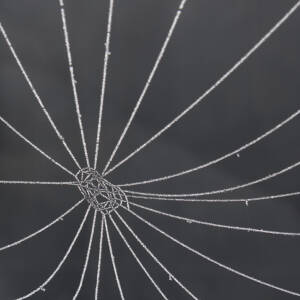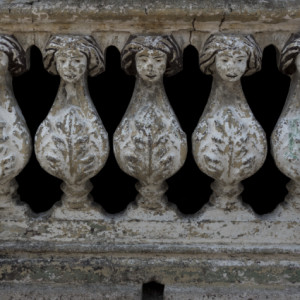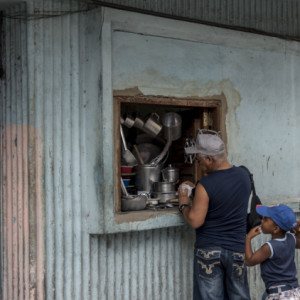Quietly hoping she buys
Between Old Havana, where we’re staying, and Vedado, ‘the cultural heart of the city’, is Centro where ordinary people live ordinary lives. Many tourists, apparently, either glimpse it through the windows of a taxi as they whizz past the disarming Capitol (looking just like the one in Washington but smaller) and through Centro’s narrow, pot-holed streets, or by-pass it on the Malecon – the coast road at the north edge of the city.
Of course I wanted to walk through Centro and if we could have time in Vedado at the other end that was a bonus. We started along the Malecon, where the wind was crashing waves into the sea wall, then dipped south into dusty, crumbly, sun-pastelled Centro. Before the revolution, it was the commercial part of town, with glamorous department stores visited by Hollywood names. La Epoca still exists and I was keen to see the allegedly counterfeit goods inside but was defeated by the practice of having to queue to hand in all your bags before you go in, then queue afterwards to retrieve them. I am old, I am cynical: I do not part company with my passport, my wallet or my camera.
Instead we stared at the trees growing out of cracks in once-grand art deco balconies, wondered at a balustrade at the edge of the pavement made from delightful smiling caryatids and puzzled over a hotch-potch of living space precariously tacked somehow onto the back of a tenement wall. We looked at tiny shops operating out of windows in otherwise blank walls, the street seller walking round with multi-coloured brooms over her shoulder, another with a few buckets of fresh flowers on a converted child’s buggy, hoping and hoping for custom before the flowers wilted.
It is Sunday, the day, we’d been told, to visit Callejón de Hamel, home to ‘Afro-Cuban culture’, the Santeria religion and rumba, where ‘raw and hypnotic interlocking drum patterns and rhythmic chants summon up the orishas’ (spirits). As we got near we could hear over-amplified, badly-recorded music. A bit nearer, the alley, brightly painted with African motifs and with small shrines set into its walls, came into view, along with jostling locals and tourists. We were instantly accosted to buy a ‘solidarity CD’, with all takings going to a local school for deprived children. We said we wanted to spend time there before buying and our young ‘community activist’ argued that we should buy now. We resisted and he switched up a notch towards aggression and tried to persuade us come back to him and not buy any of the ‘fake’ ‘solidarity CDs’ being sold at other points down the street. Hmm. OK. Getting the message. Moments later we were offered a different, overpriced ‘solidarity CD’, a meal, a drink, another CD, another drink. We wondered if it would be less commercial nearer the middle of the street but it wasn’t. Disappointing. The murals, painted by Cuban artist Salvador Gonzáles Escalona are quirky and fun and I’m sure that once this really was a place of Afro-Cuban culture but we got out as fast as we could, photoless. (You’ll just have to google.)
Deep breath, regroup and walk on to Vedado. By the grand steps up to the main university entrance we sat in a café surrounded by people reading or tapping at laptops. Studious and quiet, in strong contrast to where we’d come from. Vedado also has restaurants, bars and high-rise blocks overlooking parks and the sea. Some were obviously very desirable back in the 50s but I was alarmed at their condition: eroded concrete at the corners, missing cladding and small trees growing in the cracks in the concrete. I felt I had to keep looking in case I was the witness to their collapse.
We visited Coppelia, Havana's huge ice cream place in a park, and were at first bemused by the various stands selling the ice cream – where to start? – and then embarrassed as we were ushered away from the slow queues for ordinary Cuban families out for a Sunday afternoon treat, up some stairs and into an air-conditioned room where foreigners and the rich together eat the same ice cream at much greater cost. Not the nicest experience.
Also in Vedado is the US ’Interests Section’, its alternative to an embassy in a country where it does not have diplomatic relations, worth seeing as the site of some silly antics over the years. After diplomatic relations ended in 1961 the embassy, built in 1953 on a desirable site by the sea, was out of use until 1977 when Jimmy Carter and Fidel Castro agreed that the building could reopen as a ‘US Interests Section’. That worked until 2006 when, guess who, George W. Bush, decided to annoy Castro and ‘convey hope and liberty to a tropical gulag’ by installing a scrolling electronic sign with 5-foot high red letters flashing messages in Spanish from the 25 windows at the top of the building such as: ‘I have a dream that one day this nation will rise up’, ‘No man is good enough to govern another man without that other's consent', and ‘Some go around in Mercedes, some in Ladas, but the system forces almost everyone to hitch rides’. In response, Castro marched a million protesters past, dug up the US mission's car park, renamed the area fronting the building Plaza Anti-Imperialista, erected 138 huge black flags to block the messages and ‘commemorate victims of US aggression’, and installed massive billboards with anti-US slogans and an image of Bush with bloodied fangs. All good stuff and apparently a major tourist attraction but sadly we missed most of it because Obama pulled the plug on the scrolling messages in 2009. So we saw only the plaza, the flag-poles, now bearing Cuban flags, and much gentler communist slogans: ‘patria o muerte’ (fatherland or death) and ‘venceremos’ (we will prevail/win).
Today was our last full day in Havana so back in the old town we decided to have a farewell meal. The rapid expansion of private enterprise means that new restaurants open regularly and guide books are little use so we went exploring around the narrow streets. We were captivated by a violinist and guitarist playing above our heads on a restaurant balcony and that made the decision. The food turned out to be excellent, the company at the adjoining table fascinating – a diplomat and an Economist journalist who had to wait seven months for a visa (ours took about seven minutes) – and our young waiter most interesting. He had given up on his Cuban IT degree and wanted only to earn enough money to get to the USA. As a waiter in a private enterprise he was earning seven times his father’s salary and reckoned Cuba was a disaster. We pointed out some of the downsides of capitalism, he fought back robustly. His coup at the end of the evening was to tell us that the two women washing up in the kitchen to supplement daytime wages they could not live on were both doctors in a state hospital. Our sad coup, in the battle of rights and wrongs, was to point out an overcharge on our bill, which he deftly blamed on an incompetent cashier ‘who often makes mistakes’. He’ll go far.
Some more in Extras.




Comments
Sign in or get an account to comment.


